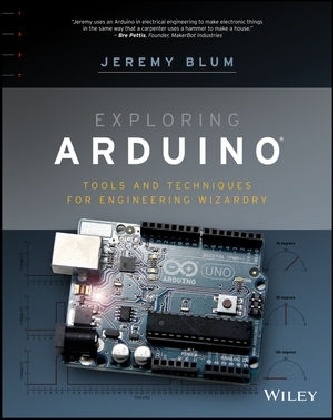Condividi
J Blum, J. Blum, Jacques Blum, Jeremy Blum
Exploring Arduino - Tools and Techniques for Engineering Wizardry
Inglese · Tascabile
Descrizione
Offers lessons on using the Arduino microcontroller platform to create a variety of projects, along with information on electrical engineering, programming, and human-computer interaction.
Sommario
Introduction xix
Part I Arduino Engineering Basics 1
Chapter 1 Getting Up and Blinking with the Arduino 3
Exploring the Arduino Ecosystem 4
Arduino Functionality 4
Atmel Microcontroller 6
Programming Interfaces 6
General I/O and ADCs 7
Power Supplies 7
Arduino Boards 8
Creating Your First Program 13
Downloading and Installing the Arduino IDE 13
Running the IDE and Connecting to the Arduino 14
Breaking Down Your First Program 16
Summary 18
Chapter 2 Digital Inputs, Outputs, and Pulse-Width Modulation 19
Digital Outputs 20
Wiring Up an LED and Using Breadboards 20
Working with Breadboards 21
Wiring LEDs 22
Programming Digital Outputs 24
Using For Loops 25
Pulse-Width Modulation with analogWrite() 27
Reading Digital Inputs 29
Reading Digital Inputs with Pulldown Resistors 29
Working with "Bouncy" Buttons 32
Building a Controllable RGB LED Nightlight 35
Summary 39
Chapter 3 Reading Analog Sensors 41
Understanding Analog and Digital Signals 42
Comparing Analog and Digital Signals 43
Converting an Analog Signal to a Digital One 44
Reading Analog Sensors with the Arduino: analogRead() 45
Reading a Potentiometer 45
Using Analog Sensors 50
Working with Analog Sensors to Sense Temperature 52
Using Variable Resistors to Make Your Own Analog Sensors 54
Using Resistive Voltage Dividers 55
Using Analog Inputs to Control Analog Outputs 56
Summary 59
Part II Controlling Your Environment 61
Chapter 4 Using Transistors and Driving Motors 63
Driving DC Motors 65
Handling High-Current Inductive Loads 65
Using Transistors as Switches 66
Using Protection Diodes 67
Using a Secondary Power Source 68
Wiring the Motor 68
Controlling Motor Speed with PWM 70
Using an H-Bridge to Control DC Motor Direction 72
Building an H-bridge Circuit 73
Operating an H-bridge Circuit 76
Driving Servo Motors 80
Understanding the Difference Between Continuous Rotation and Standard Servos 80
Understanding Servo Control 80
Controlling a Servo 85
Building a Sweeping Distance Sensor 86
Summary 90
Chapter 5 Making Sounds 91
Understanding How Speakers Work 92
The Properties of Sound 92
How a Speaker Produces Sound 94
Using tone() to Make Sounds 95
Including a Definition File 95
Wiring the Speaker 96
Making Sound Sequences 99
Using Arrays 99
Making Note and Duration Arrays 100
Completing the Program 101
Understanding the Limitations of the tone() Function 102
Building a Micro Piano 102
Summary 105
Chapter 6 USB and Serial Communication 107
Understanding the Arduino's Serial Communication Capabilities 108
Arduino Boards with an Internal or External FTDI USB-to-Serial Converter 110
Arduino Boards with a Secondary USB-Capable ATMega MCU Emulating a Serial Converter 112
Arduino Boards with a Single USB-Capable MCU 114
Arduino Boards with USB-Host Capabilities 114
Listening to the Arduino 115
Using print Statements 115
Using Special Characters 117
Changing Data Type Representations 119
Talking to the Arduino 119
Reading Information from a Computer or Other Serial Device 120
Telling the Arduino to Echo Incoming Data 120
Understanding the Differences Between Chars and Ints 121
Sending Single Characters to Control an LED 122
Sending Lists of Values to Control an RGB LED 125
Talking to a Desktop App 127
Talking to Processing 127
Installing Processing 128
Controlling a Processing Sketch from Your Arduino 129
Sending Data from Processing to Your Arduino 132
Learning Special Tricks with the Arduino Leonardo (and Other 32U4-Based Arduinos) 134
Emulating a Keyboard 135
Typing Data into the Computer 135
Commanding Your Computer to Do Your Bidding 139
Emulating a Mouse 140
Summary 144
Chapter 7 Shift Registers 145
Understanding Shift Registers 146
Sending Parallel and Serial Data 147
Working wit
Dettagli sul prodotto
| Autori | J Blum, J. Blum, Jacques Blum, Jeremy Blum |
| Editore | Wiley, John and Sons Ltd |
| Lingue | Inglese |
| Formato | Tascabile |
| Pubblicazione | 09.08.2013 |
| EAN | 9781118549360 |
| ISBN | 978-1-118-54936-0 |
| Pagine | 384 |
| Dimensioni | 190 mm x 235 mm x 20 mm |
| Categorie |
Saggistica
> Natura, tecnica
Scienze naturali, medicina, informatica, tecnica > Informatica, EDP |
Recensioni dei clienti
Per questo articolo non c'è ancora nessuna recensione. Scrivi la prima recensione e aiuta gli altri utenti a scegliere.
Scrivi una recensione
Top o flop? Scrivi la tua recensione.

